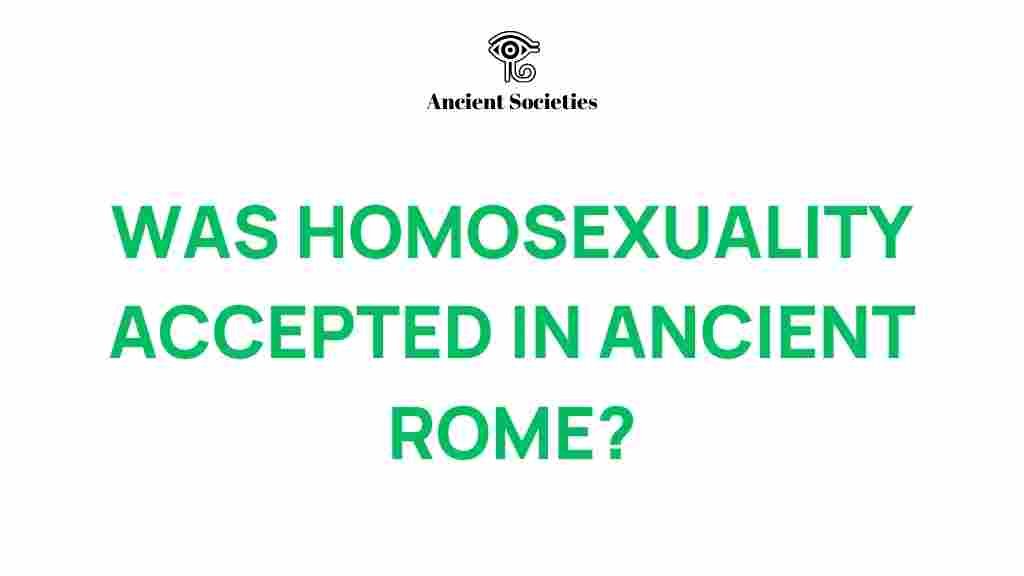Unveiling Ancient Rome: Was Homosexuality Truly Accepted?
The culture and history of Ancient Rome are rich and complex, marked by various social norms and practices that differed significantly from modern perceptions of sexuality. One of the most intriguing aspects of Roman society is its approach to homosexuality. How was it accepted, and what does it reveal about the relationships and social structures of the time? In this article, we delve into the intricate dynamics of homosexuality in Ancient Rome, examining the acceptance of different sexualities and the cultural implications they held.
Understanding the Cultural Context
To appreciate the acceptance of homosexuality in Ancient Rome, we must first explore the cultural context of the era. Roman society was largely patriarchal, and social norms dictated the roles of men and women in relationships. Here are some key aspects of this cultural framework:
- Patriarchy: Men held dominant roles in society, and their sexual relationships often reflected their status.
- Citizenship: Roman citizenship played a significant role in defining social interactions, including sexual relationships.
- Social Hierarchies: Class distinctions influenced who could engage in homosexuality and under what circumstances.
The Acceptance of Homosexuality in Ancient Rome
In contrast to many cultures that followed, Ancient Rome exhibited a level of acceptance toward homosexuality. However, this acceptance was nuanced and often contingent on specific social norms. Let’s explore some critical factors that contributed to this phenomenon:
- Male Relationships: Romantic and sexual relationships between men were relatively common and often viewed as normal, particularly when involving older men and younger boys or adolescents.
- Social Status: The acceptance of homosexuality depended greatly on one’s social status. Freeborn men could engage in same-sex relationships without stigma, provided they assumed the dominant role.
- Public Perception: While same-sex relationships were tolerated, they were often subjected to public scrutiny, especially if they challenged traditional gender roles.
Sexuality and Social Norms
The social norms surrounding homosexuality in Ancient Rome were complex. Roman men were expected to exhibit masculinity, and engaging in same-sex relationships was often only acceptable if it did not compromise their masculine identity. Here are some critical points about sexuality and social norms:
- Masculine Dominance: Roman ideals emphasized masculine dominance, which meant that men who were penetrative in same-sex relationships maintained their social standing.
- Passive Roles: Men who took on passive roles in same-sex relationships faced social stigma and were often viewed as effeminate.
- Relationships with Slaves: Many wealthy Romans engaged in sexual relationships with their male slaves, which reflected power dynamics rather than romantic love.
Historical Perspectives on Homosexuality
Various historical sources provide insight into how homosexuality was perceived and accepted in Ancient Rome. Key figures, literature, and archaeological findings reveal a multifaceted view of sexual relationships:
- Literary Sources: Works by poets like Catullus and Martial often celebrated male love and relationships.
- Philosophical Discourses: Philosophers such as Plato influenced Roman thought on love, including same-sex attraction.
- Archaeological Evidence: Artifacts, frescoes, and inscriptions have uncovered evidence of same-sex relationships, indicating a level of acceptance in certain contexts.
The Role of Women in Ancient Roman Sexuality
Women’s roles in Ancient Rome and their experiences with homosexuality are often overlooked. While male same-sex relationships received more attention, women also engaged in same-sex relationships, albeit in a more clandestine manner:
- Limited Freedom: Women had less autonomy in sexual relationships compared to men, which affected their ability to form same-sex bonds.
- Literary References: Some texts suggest that women expressed affection for one another, though these relationships were often shrouded in secrecy.
Controversies and Social Reactions
Despite the relative acceptance of homosexuality, there were controversies and social reactions that reflected the tension between public morality and personal behavior:
- Political Scandals: High-profile cases of homosexuality could lead to political scandals, as seen in the cases of emperors like Nero.
- Religious Influences: As Christianity began to rise, attitudes toward homosexuality shifted significantly, leading to increased stigma.
Exploring LGBTQ+ Connections in Ancient Rome
The exploration of LGBTQ+ identities in Ancient Rome is an evolving field in archaeology and history. Understanding the past helps contextualize current discussions about sexuality and acceptance:
- Identity Formation: Ancient texts reveal the fluidity of sexual identities, challenging modern binary notions of homosexuality.
- Archaeological Insights: Recent archaeological findings continue to shed light on the diversity of sexual relationships in the Roman Empire.
Challenges in Historical Interpretation
Interpreting the history of homosexuality in Ancient Rome presents several challenges:
- Textual Limitations: Much of the literature from this period is fragmented, and interpretations can vary widely.
- Modern Biases: Contemporary views on sexuality may distort our understanding of ancient practices and beliefs.
Conclusion: The Legacy of Homosexuality in Ancient Rome
The acceptance and practice of homosexuality in Ancient Rome reveal a society that was complex and multifaceted. While there were norms and expectations that shaped sexual relationships, the existence of same-sex love and desire suggests a level of acceptance that contrasts sharply with later historical periods.
Today, as we reflect on the legacy of homosexuality in Ancient Rome, it is essential to recognize the cultural, social, and historical factors that influenced these relationships. By examining the past, we can better understand the ongoing struggles and triumphs of the LGBTQ+ community today.
For more insights into the intersection of history and sexuality, visit this resource. You can also explore our related article on the evolution of LGBTQ+ rights.
This article is in the category Culture and created by AncientSocieties Team
